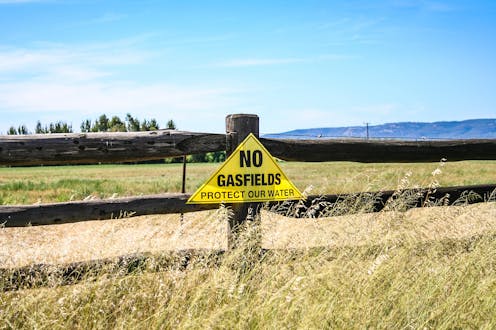 mantisdesign/Shutterstock
mantisdesign/ShutterstockOver the last decade, several groups in Australia have successfully mobilised against fossil fuel interests. But which ones have gone the distance?
The urgent global threat of climate change might suggest groups running large-scale campaigns are the ones likely achieve lasting change. But my research suggests groups focused on local efforts are often more successful.
I’ve studied coalitions and campaigns, the climate movement and people-power globally. I’ve found groups with strong local roots can evolve and endure better than larger, more dispersed groups.
The trajectory of two major environmental groups in Australia demonstrate the point.
The first is focused around the Northern Rivers in New South Wales. There, the threat of gas extraction in the 2010s prompted the community to start organising through the national anti-gas group Lock the Gate. When floods struck the region in 2017 and 2022, many organisers shifted focus to form a new, successful alliance.
The second is the Stop Adani group. Organising began around 2010 after plans for the giant Adani coal mine in central Queensland were announced. The group successfully reduced the size of the proposed mine, but energy behind the movement dwindled.
Examining the way these groups organised and operated – and how long they lasted – offers lessons for others.
Northern Rivers
The Northern Rivers region has attracted environmentally-minded people from the 1960s peace movement onward. This activist history was almost certainly not considered by gas companies when they began planning large-scale fracking operations.
Locals began meeting under the banner “Lock the Gate”. In 2014, they launched the Bentley Blockade camp-in on land earmarked for gas extraction. The campaign worked and the Northern Rivers remains gasfield-free.
When unprecedented floods hit in 2017 and 2022, locals involved in Lock the Gate shifted focus. They formed the Northern Rivers Community Resilience Alliance to work on mutual aid and ongoing resilience.
Stop Adani
In 2010, the multinational Adani Group announced plans for the Carmichael coal mine in Queensland’s Galilee Basin. Climate groups around the country were outraged.
People began campaigning against the mine, initially locally focused on the coal port. By 2017 the campaign became national under the banner Stop Adani.
By 2017, Stop Adani had built a national strategy coordinating more than 100 community groups across many cities and regions. The movement used public pressure to slow progress. It reduced but did not stop the mine, which began exporting coal in late 2021.
Who was in these groups?
To tackle the gasfield threat, Northern Rivers residents doorknocked neighbours and local councils voted to declare their region gasfield free. Lock the Gate organisers deliberately set out to make their group as representative as possible.
Disagreements were inevitable. Farmers worried about the effect of gasfields on groundwater while environmentalists focused on the climate. But their relationships in the same place helped maintain unity. This broad base also meant opponents couldn’t write them off as “angry greenies”. As organiser Annie Kia has said, the movement “maximised self-organisation”.
By contrast, my analysis and interviews have shown Stop Adani involved local groups mostly comprised of white, middle class, well-educated urban women from the east coast. This made it easier to find agreement. But individual groups were smaller and less diverse than the Northern Rivers group.
Who designed the strategy?
Northern Rivers organisers tapped experienced campaigners to create the strategy. This helped overcome tensions within the broad coalition and arguably drove more creativity.
The Stop Adani strategy was done nationally. Community groups were invited to plan coordinated local actions. The led to effective public pressure on banks financing the mine, and other organisations.
But national-local separation comes at a cost, as my research has found. Local groups tasked with carrying out a national plan and had less ability to build their own plans.
Framing matters
Both groups focused on stopping fossil fuel extraction, but their framing differed.
Northern Rivers residents were motivated by a range of concerns, from avoiding damage to water tables to tackling climate change. To harness these motivations, the group framed their demand positively – fighting for a gasfield-free Northern Rivers region.
Stop Adani was built on a simple negative: stop the mine. This drove urgency and led to high levels of participation. But it also prompted a backlash, such as tense stand-offs between Central Queensland residents and a convoy organised by Bob Brown against the mine in 2019.
The stark framing created a challenge in negotiating with government. But success is not always black or white. State and federal governments slashed the size of the mine to just one-sixth the size of the original plans.
The negative framing also made it hard to retain participants. When years of protests failed to stop the mine, mass participation fell away.
But Stop Adani didn’t give up. In recent years, Traditional Owners have kept up the pressure on the mine’s financial and political backers.
What does success look like?
Stop Adani and Northern Rivers had very similar goals: stop the mine, stop the gasfields. By this metric, both groups were largely successful.
But Northern Rivers organisers also focused on building a broad movement beyond the usual environmentally-minded people. That’s why the group is still going strong, even after gas plans were defeated.
This is a remarkable community asset. When much of Lismore went underwater in 2022, state and federal help was slow. So community groups sprang into action, pooling resources and cooperating during the immediate emergency and the long clean-up.
Other communities now look to the Northern Rivers as a model of ground-up disaster recovery.
Their success should give us hope. As the climate warps, groups with strong community roots are well-placed to lead the response to the changing demands of the climate crisis.
Amanda Tattersall receives funding from Lord Mayor's Charitable Trust and the Sunrise Project.

 3 hours ago
37
3 hours ago
37

